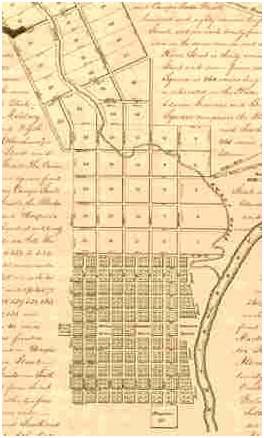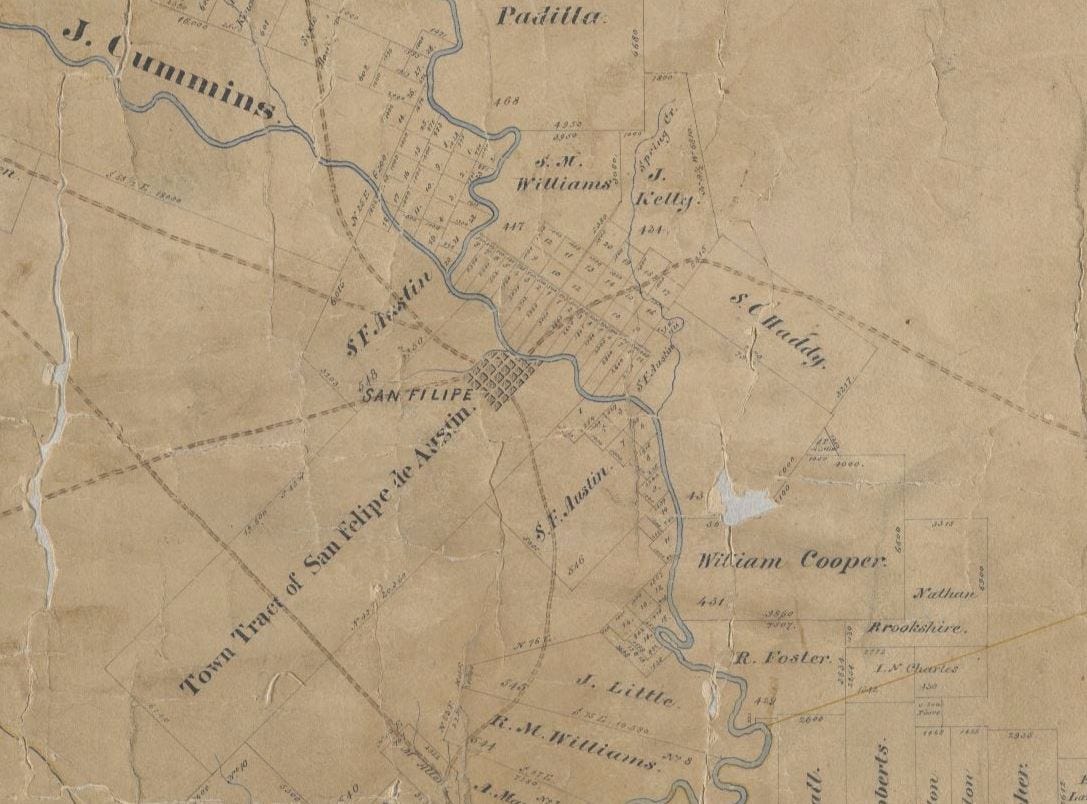San Felipe de Austin is located on the west bank of the Brazos River at the Old San Antonio Road crossing, a site now on Interstate Highway 10 two miles east of Sealy. Several large cotton plantations were established in the bottomlands near the town during the 1820s, and from the outset San Felipe became a trading center for the staple.
By October 1823, with the assistance of the Baron de Bastrop, Austin decided to establish his capital on the Brazos near the settlement which operated a ferry. The site was on a high, easily defensible bluff overlooking broad, fertile bottomlands. The location offered a central location and sources of fresh water independent of the Brazos.
It was founded in 1824 Founded in 1824 by Stephen F. Austin as San Felipe de Austin, the capital of his colony, the town served as the founding spot of the Texas Rangers. It became the first urban center in the Austin colony, which stretched northward from the Gulf of Mexico as far as the Old San Antonio Road and extended from the Lavaca River in the west to the San Jacinto River in the east.
By 1828 the community comprised a population of about 200, three general stores, two taverns, a hotel, a blacksmith shop, and some forty or fifty log cabins. It was during this time that the Masonic brethren met to petition the Grand York Rite Lodge of Mexico to establish a Masonic Lodge to be called the Lodge of Union. The town, generally called simply San Felipe, was the unquestioned social, economic, and political center of the Austin colony. Its expanding but unstable population was swelled by large numbers of immigrants and other transients.
Austin built a residence on Bullinger's Creek, a half mile west of the Brazos, from which he directed the government of his colony for four years before handing responsibility for the management of most affairs to the ayuntamiento of San Felipe in 1828. The colonial land office was headquartered in the town, and Austin assumed an active role in its operation.
Regular mail service in the colony was inaugurated in 1826 when Samuel May Williams was appointed postmaster in San Felipe; with seven separate postal routes converging there, the town remained the hub of the Texas postal service until the Texas Revolution.
One of the earliest newspapers in Texas, the Texas Gazette, began publication in San Felipe on September 25, 1829, under the editorship of Godwin B. Cotten. Gail Borden's Telegraph and Texas Register, which became the unofficial journal of the revolution, was first published in San Felipe on October 10, 1835.
San Felipe was located only some eighty miles above the mouth of the Brazos, and keelboats were used extensively to transport goods between the town and various coastal ports. Nevertheless, most articles of commerce were carried overland to the coast by wagon until after the revolution. Unreliable water levels and turbulence during the spring rains discouraged steamboat traffic on the Brazos as far as San Felipe, and the stream's meanders rendered the water route to the coast far longer than land routes. However, after 1830 steamboats gradually began to appear on the lower Brazos, and by 1836 as many as three steamboats plied the waters between San Felipe and the coast.
The first school in the town, an "English school," was established by Thomas J. Pilgrim in 1829 with an initial enrollment of forty pupils, mostly boys. He also began conducting the first Sunday school in Texas at San Felipe. By 1830 four schools were reported in the community, with a combined enrollment of seventy-seven. Although the settlement, like the rest of Austin's colony, was Catholic by law, no priest resided in San Felipe until the arrival of Father Michael Muldoon in 1831. Inasmuch as Austin discouraged the establishment of Protestant churches, Protestant worship in the town was confined mainly to occasional open-air meetings conducted by itinerant ministers. Not until after the revolution were the town's first churches built. Some of the earliest Masonic meetings in Texas convened at the town.
By the eve of the revolution San Felipe ranked second in Texas only to San Antonio as a commercial center. Its population in 1835 approached 600, and many more settlers resided nearby within the boundaries of the municipality. In view of the significance of the capital in the life of the colony, it was inevitable that San Felipe should play an important role in the events of the Texas Revolution. The Conventions of 1832 and 1833 were held in the town, and as the site of the Consultation of November 3, 1835, San Felipe served as the capital of the provisional government until the Convention of 1836 met the following March at Washington-on-the-Brazos.
After the fall of the Alamo, Gen. Sam Houston's army retreated through San Felipe. On March 30, 1836, the small garrison under Moseley Baker remaining at San Felipe to defend the Brazos crossing ordered the town evacuated and then burned it to the ground to keep it from falling into the hands of the advancing Mexican army. The terrified residents hastily gathered what few belongings they could carry before fleeing eastward during the incident known as the Runaway Scrape.
By May 1836, as news of the Texans' victory at the battle of San Jacinto spread, San Felipeans began to return, and a semblance of community life was soon restored near the original townsite. Yet many families never returned, and the government of the republic was unable to resume operation in the town for want of the necessary buildings.
San Felipe was incorporated in 1837 and became county seat of the newly established Austin County. Though a courthouse was constructed, the town never recovered its former stature. By the mid-1840s the only other buildings in the settlement were six or seven log houses and a tavern. In 1846 a county election made the new community of Bellville the county seat; the removal of administrative functions from San Felipe was completed in January 1848.
In the mid-1870s the people of San Felipe declined an offer by the Gulf, Colorado and Santa Fe Railway to route its new Galveston-Brenham spur through their town. Instead, the railroad was sold a right-of-way through the western section of the original 22,000-acre municipal tract. In the early 1880s Sealy, four miles to the west, developed rapidly as a station of the new rail line, and many residents and businesses moved from San Felipe to the new commercial center.
When the Texas Western Narrow Gauge Railway constructed its Houston-Sealy spur through the vicinity in 1882, the remaining residents of San Felipe moved southward about a half mile to a new townsite along the tracks. Proceeds from the sale of lands within the original five-league township were invested, and the resulting income enabled the town to function without taxation and to build a first-rate system of public education. But in 1899 the Texas Western, a minor carrier, abandoned its Houston-Sealy line, and by 1890 the population of San Felipe had declined to 177. The population was 747 at the 2010 census.
Well into the twentieth century the residents of San Felipe continued to claim the rights of the original inhabitants to free water, wood, grazing, and burial ground on the common lands of the municipality. In 1980 more than 700 acres of open land remained in possession of the community. Most of the original townsite on the banks of Bullinger's Creek now lies within the 4,200-acre Stephen F. Austin State Historical Park, which was dedicated in 1928 and donated to the state by the town of San Felipe in 1940.
Commemorating the pivotal years of Texas’ history, San Felipe de Austin State Historic Site preserves the location where Stephen F. Austin established his colony in 1823. The park features an obelisk and a bronze statue commemorating the achievements of Stephen F. Austin, a replica of Austin's log house, and a monument on the site of the town hall, where the conventions of 1832 and 1833 and the Consultation of 1835 were held. The Farm Road 1458 bridge, constructed in the late 1940s, spans the Brazos near the site of the original ferry.
Commemorating the pivotal years of Texas’ history, San Felipe de Austin State Historic Site preserves the location where Stephen F. Austin established his colony in 1823. The park features an obelisk and a bronze statue commemorating the achievements of Stephen F. Austin, a replica of Austin's log house, and a monument on the site of the town hall, where the conventions of 1832 and 1833 and the Consultation of 1835 were held. The Farm Road 1458 bridge, constructed in the late 1940s, spans the Brazos near the site of the original ferry.
Sources:



No comments:
Post a Comment